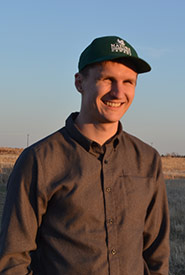Mowing for nature
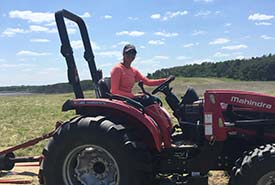
NCC intern Breanna Silverside on a tractor that pulls the industrial mower. (Photo by NCC)
“The lawn mower broke again” is a phrase I have heard from my fellow Saskatchewan Conservation Interns more than once over the summer. When they finally had the tractor and lawn mower working, they would come into the office after a day of mowing, with tan lines and sweaty brows. This isn’t your typical push lawnmower either; this is an industrial mower pulled by a tractor. And it’s no small task for a couple of Nature Conservancy of Canada (NCC) interns.
This begs the question, “Why are we mowing anyway?” As far as I know, NCC isn’t building a golf course, so why the lawn mower? In my mind, if we are keeping properties natural we shouldn’t be mowing the lawn, we should just let nature do its thing. This seems obvious to me.
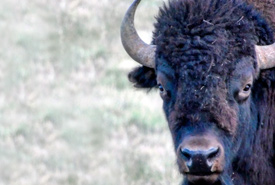
Plains bison (Photo by NCC)
Like many things with conservation, what initially seems strange to me turns out to have a reasonable and well thought-out reason behind it. The lawn mower has become one of NCC’s most important conservation tools. One of its functions is to mimic the grazing of a bison. The loss of nearly 70 million bison in the 19th century from the North American prairies has had a profound effect on prairie ecosystems. Grazing bison would naturally alter the heights of grass, which created an ever-changing landscape. Frequent prairie fires would also vary vegetation heights. But prairie wildfires have been less common since European settlement of the prairies, as previously wildfires were frequent on the prairies.
Many species can only survive in certain lengths of vegetation. Some grasses are fast growers and, after being grazed or mowed, they will sprout up quickly to gather as much sunlight as possible. This adaptation prevents them from being overtaken by slower-growing grasses that will eventually block out much of the light.
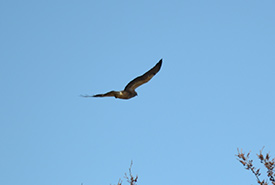
Hawk soaring in the sky (Photo by NCC)
Animals also have preferences for grass heights. Many small mice and insects that provide a tasty snack to predators prefer longer grass because they can more easily hide. Predators like hawks prefer shorter grass because they can more easily spot hiding prey.
Without mowing or grazing, the plants grow too large for many species, pushing them out of the area. It also influences which species of vegetation are able to establish and continue to persist. This can create imbalanced ecosystems. For example, if the vegetation is too thick, it can lead to too many mice or insects, because predators find it more difficult to hunt. The mice and insects will only eat certain plants, which they can eat until they extinguish a plant species from an area. This can start a cycle of species loss, where after one species is lost it can cause another species to be lost.
All of this can be avoided by strategically mowing parts of an area. This allows some areas to grow longer for the species that prefer long grasses, and other areas remain shorter for species with that preference. Just a quick mow on one NCC property can lead to much greater species diversity in the area.
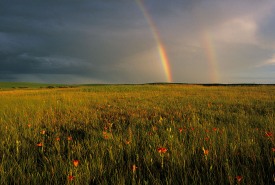
Saskatoon Prairie Natural Area, Saskatchewan (Photo by Branimir Gjetvaj)
Mowing isn’t just about mimicking bison, it is also needed to control invasive weed species that can harm an ecosystem. This is especially important on native prairie restoration projects that may not be able to support livestock grazing just yet.
By mowing the weeds, they won’t be able to spread as quickly, and their harmful effects can be mitigated. Mowing can also be timed to have a greater impact on weeds — with little impact on native species. This is because native species usually have a later growing season compared to invasives. This gives a competitive edge to the more desirable native species. Dealing with invasive species is an ongoing challenge across the country, and strategically mowing the weeds is an effective management tool.
The grass clippings aren’t wasted either. They are left on the ground, which creates a litter of cuttings underneath the still-growing grass. At the right length, this litter reduces soil loss from wind and creates habitat for insects and other small creatures. Also, the breakdown of this material over time lays nutrients back into the soil to promote the continued growth of plants. It’s a kind of slow-release self-fertilization.
It is unfortunate that many prairie ecosystems have been damaged to the point that they need intervention to survive, but we have the tools to keep these ecosystems viable. NCC encourages grazing by bison or cows on most Saskatchewan properties, but sometimes you just have get your hands dirty and do some mowing.
The Conservation Internship Program is funded in part by the Government of Canada’s Summer Work Experience program.

